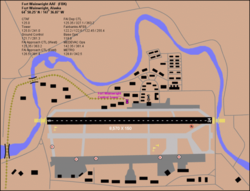Ladd AFB
|
Ladd Army Airfield (Ladd Air Force Base) |
|||||||||||
|---|---|---|---|---|---|---|---|---|---|---|---|
 |
|||||||||||
| Summary | |||||||||||
| Airport type | Military: Army Airfield | ||||||||||
| Operator | United States Army | ||||||||||
| Serves | Fort Wainwright | ||||||||||
| Location | Fairbanks, Alaska | ||||||||||
| Built | 1938 | ||||||||||
| Elevation AMSL | 454 ft / 138 m | ||||||||||
| Coordinates | 64°50′15″N 147°36′52″W / 64.83750°N 147.61444°WCoordinates: 64°50′15″N 147°36′52″W / 64.83750°N 147.61444°W | ||||||||||
| Website | www.wainwright.army.mil | ||||||||||
| Map | |||||||||||
| Location of airport in Alaska | |||||||||||
| Runways | |||||||||||
|
|||||||||||
|
Source: Federal Aviation Administration
|
|||||||||||
|
Ladd Field
|
|
| NRHP Reference # | 85002730 |
|---|---|
| Significant dates | |
| Added to NRHP | February 4, 1985 |
| Designated NHL | February 4, 1985 |
Ladd Army Airfield (IATA: FBK, ICAO: PAFB, FAA LID: FBK) is the military airfield located at Fort Jonathan Wainwright, located in Fairbanks, Alaska. It was originally called Fairbanks Air Base, but was renamed Ladd Field on 1 December 1939, in honor of Major Arthur K. Ladd, a pilot in the U.S. Army Air Corps who died in a plane crash near Dale, South Carolina on 13 December 1935.
The U.S. government began, for the first time, serious infrastructure expenditures in Alaska during the 1930s. Most prominent was an increase in the military presence. For most of the early 20th century, the only Army post in Alaska was Chilkoot Barracks/Fort Seward, located just outside Haines. With the threat of war looming as the 1930s ended, the need was established to develop multiple facilities as a means of defending Alaska against possible enemy attack.
The U.S. government acquired homesteads southeast of the town of Fairbanks beginning in 1938. From this land, totalling about 6 square miles (16 km2), was created Ladd Field. The first aircraft to land at Ladd was Douglas O-38F, 33-324, c/n 1177, in October 1940, which is now preserved in the National Museum of the United States Air Force. Major construction of facilities began in 1941 and 1942, after the U.S. entered World War II. The initial construction occurred several miles from Fairbanks along a bend of the Chena River, consisting of an airfield, hangars, housing and support buildings. Many of these buildings still stand today.
Alaska's transportation infrastructure at the time was so limited and the problem of military supply so acute, it also made sense to concentrate the bases along existing supply lines near Anchorage and Fairbanks. Ladd's location near Fairbanks, the Richardson Highway and the Alaska Railroad, its access to fuel from the CANOL pipeline, and its position at the time as one of the United States' northernmost developed airbases were important factors in securing its early Cold War prominence.
...
Wikipedia

